Micro-Nanoarchitectonics of Ga2O3/GaN Core-Shell Rod Arrays for High-Performance Broadband Ultraviolet Photodetection
Abstract
1. Introduction
2. Materials and Methods
3. Results
4. Conclusions
Author Contributions
Funding
Conflicts of Interest
References
- Aslam, S.; Miko, L.; Stahle, C.; Franz, D.; Pugel, D.; Guan, B.; Zhang, J.; Gaska, R. Dual-band deep ultraviolet AlGaN photodetectors. Electron. Lett. 2007, 43, 1382–1384. [Google Scholar] [CrossRef]
- Assefa, S.; Xia, F.; Vlasov, Y.A. Reinventing germanium avalanche photodetector for nanophotonic on-chip optical interconnects. Nature 2010, 464, 80–84. [Google Scholar] [CrossRef] [PubMed]
- Gong, X.; Tong, M.; Xia, Y.; Cai, W.; Moon, J.S.; Cao, Y.; Yu, G.; Shieh, C.-L.; Nilsson, B.; Heeger, A.J. High-Detectivity Polymer Photodetectors with Spectral Response from 300 nm to 1450 nm. Science 2009, 325, 1665–1667. [Google Scholar] [CrossRef] [PubMed]
- Konstantatos, G.; Sargent, E.H. Nanostructured materials for photon detection. Nat. Nanotechnol. 2010, 5, 391–400. [Google Scholar] [CrossRef] [PubMed]
- Monroy, E.; Omn, F.; Calle, F. Wide-Bandgap Semiconductor Ultraviolet Photodetectors. Semicond. Sci. Technol. 2003, 18, R33–R51. [Google Scholar] [CrossRef]
- Zheng, W.; Lin, R.; Zhang, D.; Jia, L.; Ji, X.; Huang, F. A new superconductor of cuprates with unique features. Adv. Opt. Mater. 2018, 6, 1800697. [Google Scholar] [CrossRef]
- Li, J.Z.; Lin, J.Y.; Jiang, H.X.; Khan, M.A. Effects of persistent photoconductivity on the characteristic performance of an AlGaN/GaN heterostructure ultraviolet detector. Appl. Phys. Lett. 1998, 72, 2868–2870. [Google Scholar] [CrossRef]
- Ji, L.W.; Peng, S.M.; Su, Y.K.; Young, S.-J.; Wu, C.Z.; Cheng, W.B. Ultraviolet photodetectors based on selectively grown ZnO nanorod arrays. Appl. Phys. Lett. 2009, 94, 203106. [Google Scholar] [CrossRef]
- Lupan, O.T.; Braniste, M.; Deng, L.; Ghimpu, I.; Paulowicz, Y.K.; Mishra, L.; Kienle, R.; Adelung, I.; Tiginyanu, I. Rapid switching and ultra-responsive nanosensors based on individual shell–core Ga2O3/GaN:Ox@SnO2 nanobelt with nanocrystalline shell in mixed phases. Sens. Actuators B 2015, 221, 544–555. [Google Scholar] [CrossRef]
- Yu, J.; Shan, C.X.; Huang, X.M.; Zhang, X.W.; Wang, S.P.; Shen, D.Z. ZnO-based ultraviolet avalanche photodetectors. J. Phys. D Appl. Phys. 2013, 46, 305105. [Google Scholar] [CrossRef]
- Yu, J.; Shan, C.X.; Liu, J.S.; Zhang, X.W.; Li, B.H.; Shen, D.Z. MgZnO avalanche photodetectors realized in Schottky structures. Phys. Status Solidi. RRL—Rapid Res. Lett. 2013, 7, 425–428. [Google Scholar] [CrossRef]
- Shao, Z.G.; Chen, D.J.; Lu, H.; Zhang, R.; Cao, D.P.; Luo, W.J.; Zheng, Y.D.; Li, L.; Li, Z.H. High-Gain AlGaN Solar-Blind Avalanche Photodiodes. IEEE Electron Device Lett. 2014, 35, 372–374. [Google Scholar] [CrossRef]
- Huang, Y.; Chen, D.J.; Lu, H.; Dong, K.X.; Zhang, R.; Zheng, Y.D.; Li, L.; Li, Z.H. Back-illuminated separate absorption and multiplication AlGaN solar-blind avalanche photodiodes. Appl. Phys. Lett. 2012, 101, 253516. [Google Scholar] [CrossRef]
- Tut, T.; Gokkavas, M.; Inal, A.; Ozbay, E. AlxGa1-xN-based avalanche photodiodes with high reproducible avalanche gain. Appl. Phys. Lett. 2007, 90, 163506. [Google Scholar] [CrossRef]
- Huang, Z.; Li, J.; Zhang, W.; Jiang, H. AlGaN Solar-Blind Avalanche Photodiodes with Enhanced Multiplication Gain Using Back-Illuminated Structure. Appl. Phys. Express 2013, 6, 054101. [Google Scholar] [CrossRef]
- Tut, T.; Gokkavas, M.; Butun, B.; Butun, S.; Ulker, E.; Ozbay, E. Experimental evaluation of impact ionization coefficients in AlxGa1−xN based avalanche photodiodes. Appl. Phys. Lett. 2006, 89, 183524. [Google Scholar] [CrossRef]
- Xie, X.H.; Zhang, Z.Z.; Shan, C.X.; Chen, H.Y.; Shen, D.Z. Dual-color ultraviolet photodetector based on mixed-phase-MgZnO/i-MgO/p-Si double heterojunction. Appl. Phys. Lett 2012, 101, 081104. [Google Scholar] [CrossRef]
- Xuan, H.C.; Wen, X.M.; Yang, X.; Bo, F.; Zhi, T.J.; Jian, D.Y. Highly Narrow-Band Polarization-Sensitive Solar-Blind Photodetectors Based on β-Ga2O3 Single Crystals. ACS Appl. Mater. Interfaces 2019, 11, 7131–7137. [Google Scholar]
- Kong, W.Y.; Wu, G.A.; Wang, K.Y.; Zhang, T.F.; Zou, Y.F.; Wang, D.D.; Luo, L.B. Graphene-β-Ga2O3 Heterojunction for Highly Sensitive Deep UV Photodetector Application. Adv. Mater. 2016, 28, 10725–10731. [Google Scholar] [CrossRef]
- Pratiyush, A.; Krishnamoorthy, S.; Solanke, S.S.; Xia, V.Z.; Muralidharan, R.; Rajan, S.; Nath, D.N. High responsivity in molecular beam epitaxy grown β-Ga2O3 metal semiconductor metal solar blind deep-UV photodetector. Appl. Phys. Lett. 2017, 110, 221107. [Google Scholar] [CrossRef]
- Qu, Y.; Wu, Z.; Ai, M.; Guo, D.; An, Y.; Yang, H.; Li, L.; Tang, W. Enhanced Ga2O3/SiC ultraviolet photodetector with graphene top electrodes. J. Alloys Compd 2016, 680, 247–251. [Google Scholar] [CrossRef]
- Zhao, B.; Wang, F.; Chen, H.; Zheng, L.; Su, L.; Zhao, D.; Fang, X. An Ultrahigh Responsivity (9.7 mA W− ( ) Self-Powered Solar-Blind Photodetector Based on Individual ZnO-Ga2O3 Heterostructures. Adv. Funct. Mater. 2017, 27, 1700264. [Google Scholar] [CrossRef]
- Guo, D.Y.; Liu, H.; Li, P.; Wu, Z.; Wang, S.; Cui, C.; Li, C.; Tang, W. Zero-Power-Consumption Solar-Blind Photodetector Based on β-Ga2O3/NSTO Heterojunction. ACS Appl. Mater. Interfaces 2017, 9, 1619–1628. [Google Scholar] [CrossRef] [PubMed]
- Chen, X.; Liu, K.; Zhang, Z.; Wang, C.; Li, B.; Zhao, H.; Zhao, D.; Shen, D. Self-Powered Solar-Blind Photodetector with Fast Response Based on Au/β-Ga2O3 Nanowires Array Film Schottky Junction. ACS Appl. Mater. Interfaces 2016, 8, 4185–4191. [Google Scholar] [CrossRef]
- Li, P.; Shi, H.; Chen, K.; Guo, D.; Cui, W.; Zhi, Y.; Wang, S.; Wu, Z.; Chen, Z.; Tang, W. Construction of GaN/Ga2O3 p–n junction for an extremely high responsivity self-powered UV photodetector. J. Mater. Chem. C 2017, 5, 10562–10570. [Google Scholar] [CrossRef]
- Kanika, A.; Neeraj, G.; Mahesh, K.; Mukesh, K. Ultra-high-performance of Self-Powered β-Ga2O3 Thin Film Solar-blind Photodetector Grown on Cost-Effective Si Substrate using High-Temperature Seed Layer. ACS Photonics 2018, 5, 2391–2401. [Google Scholar]
- Qian, L.-X.; Wu, Z.-H.; Zhang, Y.-Y.; Lai, P.T.; Liu, X.-Z.; Li, Y.-R. Ultrahigh-Responsivity, Rapid-Recovery, Solar-Blind Photodetector Based on Highly Nonstoichiometric Amorphous Gallium Oxide. ACS Photon. 2017, 4, 2203–2211. [Google Scholar] [CrossRef]
- Weng, W.Y.; Hsueh, T.J.; Chang, S.J.; Huang, G.J. A β-Ga2O3/GaN Hetero-Structured Solar-Blind and Visible-Blind Dual-Band Photodetector. IEEE Sens. J. 2011, 11, 5. [Google Scholar] [CrossRef]
- Guo, D.; Su, Y.; Shi, H.; Li, P.; Zhao, N.; Ye, J.; Wang, S.; Liu, A.; Chen, Z.; Li, C.; et al. Self-Powered Ultraviolet Photodetector with Superhigh Photoresponsivity (3.05 A/W) Based on the GaN/Sn:β-Ga2O3 pn Junction. ACS Nano 2018, 12, 12827–12835. [Google Scholar] [CrossRef]
- Lin, W.; Zheng, D.; Zhang, Z.; Zhang, Q.; Liao, L.; Yang, F.; Huang, F. High-Performance Graphene/β-Ga2O3 Heterojunction Deep-Ultraviolet Photodetector with Hot-Electron Excited Carrier Multiplication. ACS Appl. Mater. Interfaces 2018, 10, 22419–22426. [Google Scholar] [CrossRef]
- Kalra, A.; Vura, S.; Rathkanthiwar, S.; Muralidharan, R.; Raghavan, S.; Nath, D.N. Demonstration of High-Responsivity Epitaxial β-Ga2O3/GaN Metal–Heterojunction-Metal Broadband UV-A/UV-C Detector. Appl. Phys. Express 2018, 11, 064101. [Google Scholar] [CrossRef]
- Nakagomi, S.; Sato, T.; Takahashi, Y.; Kokubun, Y. Deep Ultraviolet Photodiodes Based on the β-Ga2O3/GaN Heterojunction. Sens. Actuators A Phys. 2015, 232, 208–213. [Google Scholar] [CrossRef]
- Zeng, C.H.; Ma, Y.J.; Zhang, B.S.; Xu, Y.M.; Kong, M. Broadband Ultraviolet Photodetector Based on Graphene/β-Ga2O3/GaN Heterojunction. Mater. Sci. Forum 2020, 1014, 131–136. [Google Scholar] [CrossRef]
- He, T.; Zhang, X.; Ding, X.; Sun, C.; Zhao, Y.; Yu, Q.; Ning, J.; Wang, R.; Yu, G.; Lu, S.; et al. Broadband Ultraviolet Photodetector Based on Vertical Ga2O3/GaN Nanowire Array with High Responsivity. Adv. Opt. Mater. 2019, 7, 1801563. [Google Scholar] [CrossRef]
- Wang, S.; Chen, K.; Zhao, H.; He, C.; Wu, C.; Guo, D.; Zhao, N.; Ungar, G.; Shen, J.; Chu, X.; et al. β-Ga2O3 Nanorod Arrays with High Light-to-Electron Conversion for Solar-Blind Deep Ultraviolet Photodetection. RSC Adv. 2019, 9, 6064–6069. [Google Scholar] [CrossRef] [PubMed]
- Kalarickal, N.K.; Xia, Z.; McGlone, J.; Krishnamoorthy, S.; Moore, W.; Brenner, M.; Arehart, A.R.; Ringel, S.A.; Rajan, S. Mechanism of Si Doping in Plasma Assisted MBE Growth of β-Ga2O3. Appl. Phys. Lett. 2019, 115, 152106. [Google Scholar] [CrossRef]
- Pratiyush, A.S.; Krishnamoorthy, S.; Kumar, S.; Xia, Z.; Muralidharan, R.; Rajan, S.; Nath, D.N. Demonstration of Zero Bias Responsivity in MBE Grown β-Ga2O3 Lateral Deep-UV Photodetector. Jpn. J. Appl. Phys. 2018, 57, 060313. [Google Scholar] [CrossRef]
- Sasaki, K.; Higashiwaki, M.; Kuramata, A.; Masui, T.; Yamakoshi, S. MBE grown Ga2O3 and its power device applications. J. Cryst. Growth 2013, 378, 591–595. [Google Scholar] [CrossRef]
- Sasaki, K.; Higashiwaki, M.; Kuramata, A.; Masui, T.; Yamakoshi, S. Growth temperature dependences of structural and electrical properties of Ga2O3 epitaxial films grown on β-Ga2O3 (010) substrates by molecular beam epitaxy. J. Cryst. Growth 2014, 392, 30–33. [Google Scholar] [CrossRef]
- Alema, F.; Hertog, B.; Mukhopadhyay, P.; Zhang, Y.; Mauze, A.; Osinsky, A.; Schoenfeld, W.V.; Speck, J.S.; Vogt, T. Solar Blind Schottky Photodiode Based on an MOCVD-Grown Homoepitaxial β-Ga2O3 Thin Film. APL Mater. 2019, 7, 022527. [Google Scholar] [CrossRef]
- Feng, Z.; Anhar Uddin Bhuiyan, A.F.M.; Karim, M.R.; Zhao, H. MOCVD Homoepitaxy of Si-Doped (010) β-Ga2O3 Thin Films with Superior Transport Properties. Appl. Phys. Lett. 2019, 114, 250601. [Google Scholar] [CrossRef]
- Seryogin, G.; Alema, F.; Valente, N.; Fu, H.; Steinbrunner, E.; Neal, A.T.; Mou, S.; Fine, A.; Osinsky, A. MOCVD Growth of High Purity Ga2O3 Epitaxial Films Using Trimethylgallium Precursor. Appl. Phys. Lett. 2020, 117, 262101. [Google Scholar] [CrossRef]
- Kneiß, M.; Hassa, A.; Splith, D.; Sturm, C.; von Wenckstern, H.; Schultz, T.; Koch, N.; Lorenz, M.; Grundmann, M. Tin-Assisted Heteroepitaxial PLD-Growth of κ-Ga2O3 Thin Films with High Crystalline Quality. APL Mater. 2019, 7, 022516. [Google Scholar] [CrossRef]
- Wang, Q.; Chen, J.; Huang, P.; Li, M.; Lu, Y.; Homewood, K.P.; Chang, G.; Chen, H.; He, Y. Influence of growth temperature on the characteristics of β-Ga2O3 epitaxial films and related solar-blind photodetectors. Appl. Surf. Sci. 2019, 489, 101–109. [Google Scholar] [CrossRef]
- Xu, C.; Liu, H.; Pan, X.; Ye, Z. Growth and characterization of Si-doped β-Ga2O3 films by pulsed laser deposition. Opt. Mater. 2020, 108, 110145. [Google Scholar] [CrossRef]
- Altuntas, H.; Donmez, I.; Ozgit-Akgun, C.; Biyikli, N. Electrical characteristics of β-Ga2O3 thin films grown by PEALD. J. Alloys Compd. 2014, 593, 190–195. [Google Scholar] [CrossRef]
- Choi, D.-W.; Chung, K.-B.; Park, J.-S. Low temperature Ga2O3 atomic layer deposition using gallium tri-isopropoxide and water. Thin Solid Film. 2013, 546, 31–34. [Google Scholar] [CrossRef]
- Comstock, D.J.; Elam, J.W. Atomic Layer Deposition of Ga2O3 Films Using Trimethylgallium and Ozone. Chem. Mater. 2012, 24, 4011–4018. [Google Scholar] [CrossRef]
- Zhou, H.; Alghamdi, S.; Si, M.; Qiu, G.; Ye, P.D. Al2O3/β-Ga2O3(-201) Interface Improvement Through Piranha Pretreatment and Postdeposition Annealing. IEEE Electron Device Lett. 2016, 37, 1411–1414. [Google Scholar] [CrossRef]
- Choi, J.-H.; Ham, M.-H.; Lee, W.; Myoung, J.-M. Fabrication and characterization of GaN/amorphous Ga2O3 nanocables through thermal oxidation. Solid State Commun. 2007, 142, 437–440. [Google Scholar] [CrossRef]
- Filippo, E.; Siciliano, M.; Genga, A.; Micocci, G.; Tepore, A.; Siciliano, T. Single crystalline β-Ga2O3 nanowires synthesized by thermal oxidation of GaSe layer. Mater. Res. Bull. 2013, 48, 1741–1744. [Google Scholar] [CrossRef]
- Lin, L.; Luo, Y.; Lai, P.; Lau, K.M. Influence of oxidation and annealing temperatures on quality of Ga2O3 film grown on GaN. Thin Solid Films 2006, 515, 2111–2115. [Google Scholar] [CrossRef]
- Oshima, T.; Kaminaga, K.; Mukai, A.; Sasaki, K.; Masui, T.; Kuramata, A.; Yamakoshi, S.; Fujita, S.; Ohtomo, A. Formation of Semi-Insulating Layers on Semiconducting β-Ga2O3 Single Crystals by Thermal Oxidation. Jpn. J. Appl. Phys. 2013, 52, 051101. [Google Scholar] [CrossRef]
- Tang, R.; Li, G.; Li, C.; Li, J.; Zhang, Y.; Huang, K.; Ye, J.; Li, C.; Kang, J.; Zhang, R.; et al. Localized Surface Plasmon Enhanced Ga2O3 Solar Blind Photodetectors. Opt. Express OE 2020, 28, 5731–5740. [Google Scholar] [CrossRef] [PubMed]
- Tang, R.F.; Li, G.Q.; Jiang, Y.; Gao, N.; Li, J.C.; Li, C.; Huang, K.; Kang, J.Y.; Wang, T.; Zhang, R. Ga2O3/GaN heterostructural ultraviolet photodetectors with exciton-dominated ultranarrow response. ACS Appl. Electron. Mater. 2021, 4, 188–196. [Google Scholar] [CrossRef]
- Wang, S.; Li, Y.W.; Xiu, X.Q.; Zhang, L.Y.; Hua, X.M.; Xie, Z.L.; Tao, T.; Liu, B.; Chen, P.; Zhang, R. Synthesis and characterization of β-Ga2O3@ GaN nanowires. Chin. Phys. B 2019, 28, 028104. [Google Scholar] [CrossRef]
- Zhang, L.Y.; Li, Y.W.; Xiu, X.Q.; Xin, G.Q.; Xie, Z.L.; Tao, T.; Liu, B.; Chen, P.; Zhang, R.; Zheng, Y.D. Preparation of vertically aligned GaN@Ga2O3 core-shell heterostructured nanowire arrays and their photocatalytic activity for degradation of Rhodamine B. Superlattices Microstruct. 2020, 143, 106556. [Google Scholar] [CrossRef]
- Ariga, K. Nanoarchitectonics: What’s coming next after nanotechnology? Nanoscale Horiz. 2021, 6, 364–378. [Google Scholar] [CrossRef]
- Sudhir, G.S.; Peyrot, Y.; Krüger, J.; Kim, Y.; Klockenbrink, R.; Kisielowski, C.; Rubin, M.D.; Weber, E.R.; Kriegseis, W.; Meyer, B.K. Effect of Mg, Zn, Si, and O on the Lattice Constant of Gallium Nitride Thin Films. MRS Online Proc. Libr. 1997, 482, 569–574. [Google Scholar] [CrossRef]
- Greco, G.; Fiorenza, P.; Giannazzo, F.; Alberti, A.; Roccaforte, F. Nanoscale electrical and structural modification induced by rapid thermal oxidation of AlGaN/GaN heterostructures. Nanotechnology 2013, 25, 025201. [Google Scholar] [CrossRef]
- Hayes, J.M.; Kuball, M.; Bell, A.T.; Harrison, I.; Korakakis, D.; Foxon, C.T. High-temperature processing of GaN: The influence of the annealing ambient on strain in GaN. Appl. Phys. Lett. 1999, 75, 2097–2099. [Google Scholar] [CrossRef]
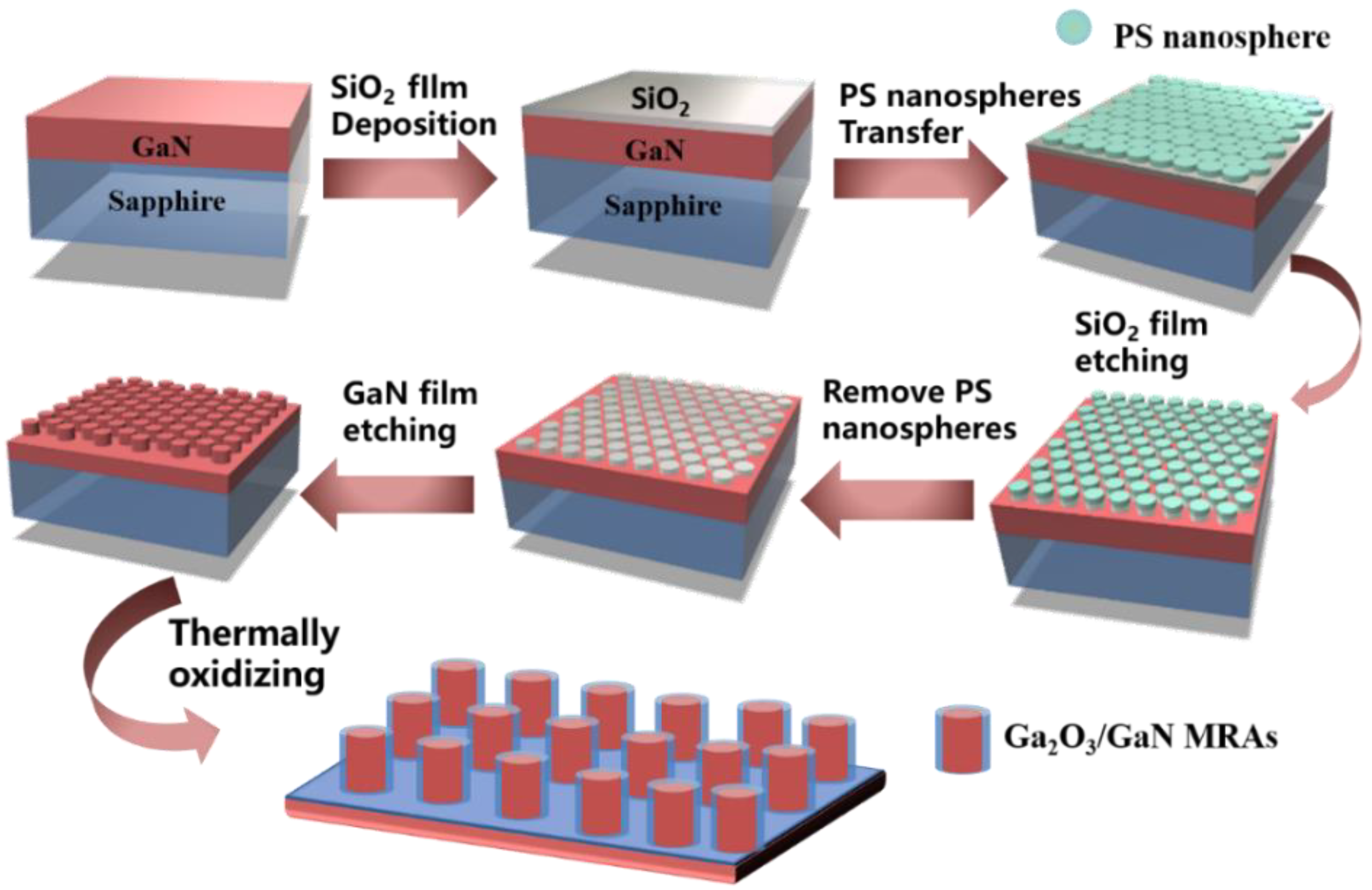
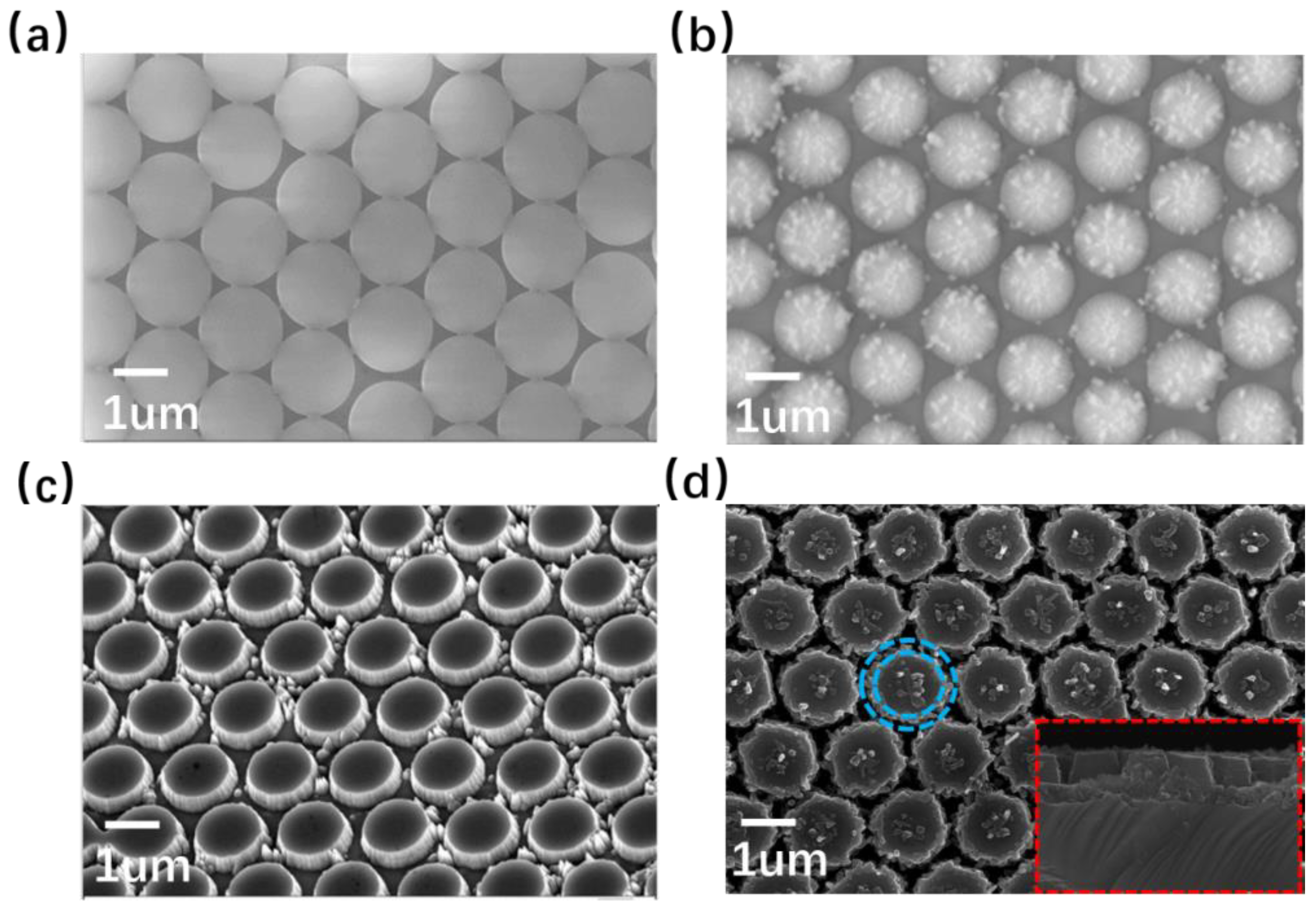

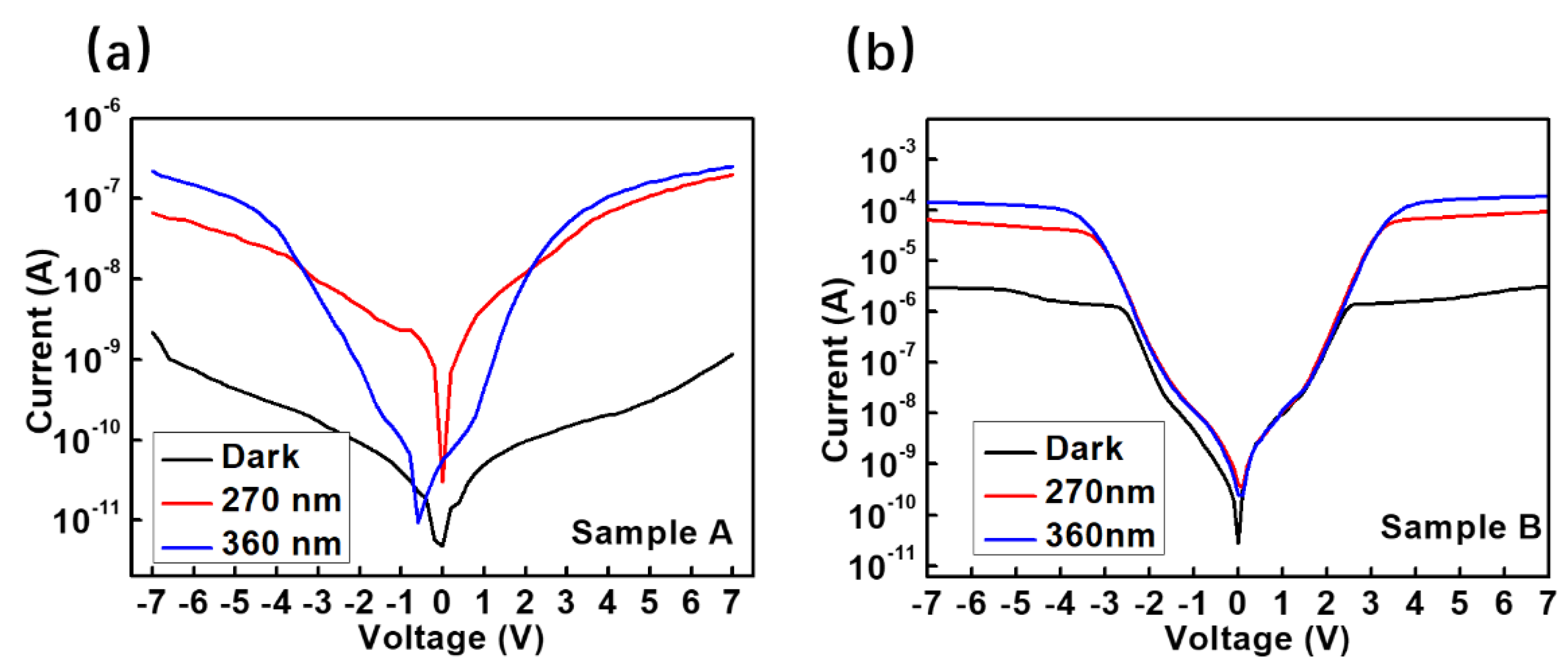
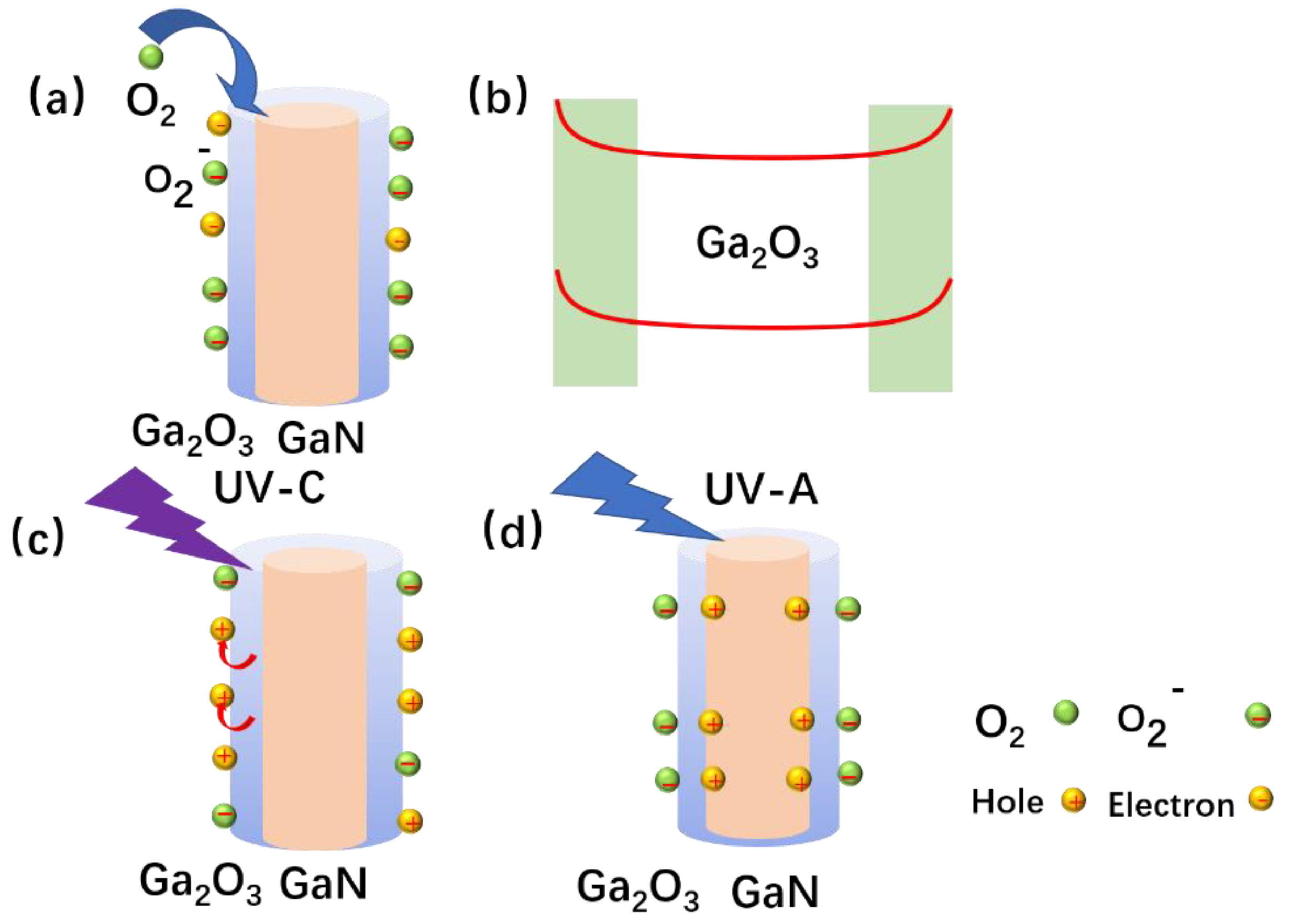

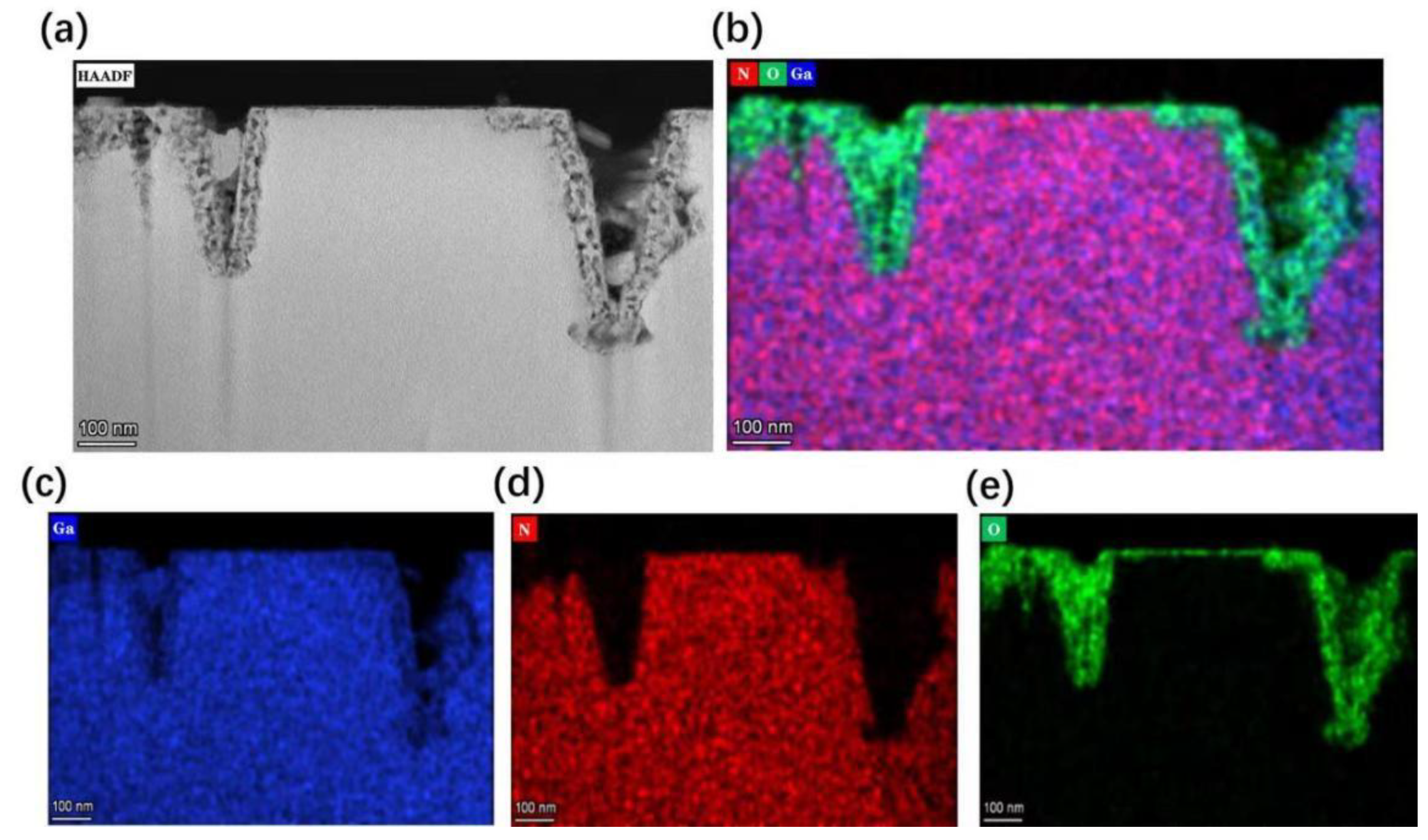
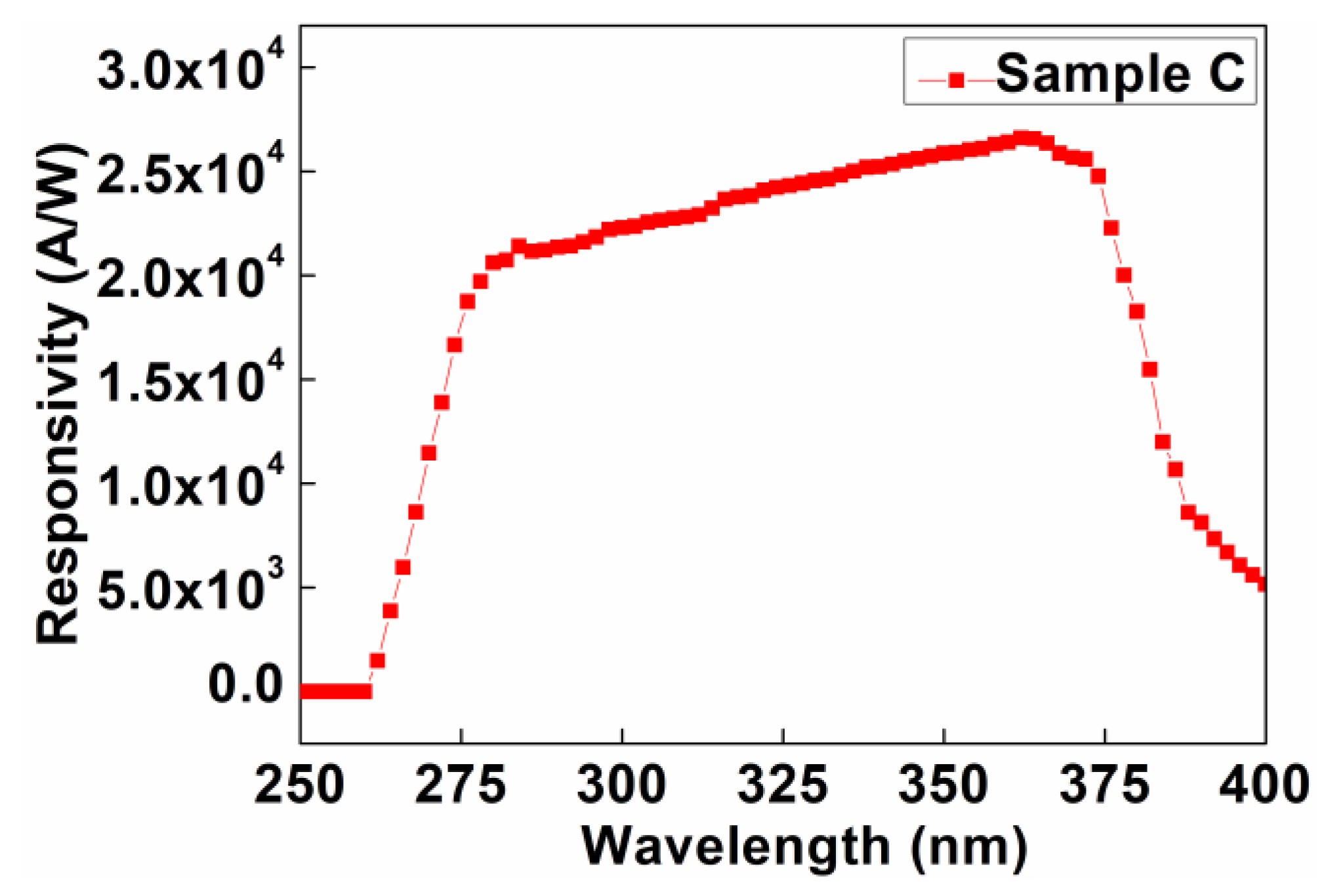
Disclaimer/Publisher’s Note: The statements, opinions and data contained in all publications are solely those of the individual author(s) and contributor(s) and not of MDPI and/or the editor(s). MDPI and/or the editor(s) disclaim responsibility for any injury to people or property resulting from any ideas, methods, instructions or products referred to in the content. |
© 2023 by the authors. Licensee MDPI, Basel, Switzerland. This article is an open access article distributed under the terms and conditions of the Creative Commons Attribution (CC BY) license (https://creativecommons.org/licenses/by/4.0/).
Share and Cite
Tang, R.; Li, G.; Hu, X.; Gao, N.; Li, J.; Huang, K.; Kang, J.; Zhang, R. Micro-Nanoarchitectonics of Ga2O3/GaN Core-Shell Rod Arrays for High-Performance Broadband Ultraviolet Photodetection. Crystals 2023, 13, 366. https://doi.org/10.3390/cryst13020366
Tang R, Li G, Hu X, Gao N, Li J, Huang K, Kang J, Zhang R. Micro-Nanoarchitectonics of Ga2O3/GaN Core-Shell Rod Arrays for High-Performance Broadband Ultraviolet Photodetection. Crystals. 2023; 13(2):366. https://doi.org/10.3390/cryst13020366
Chicago/Turabian StyleTang, Ruifan, Guanqi Li, Xun Hu, Na Gao, Jinchai Li, Kai Huang, Junyong Kang, and Rong Zhang. 2023. "Micro-Nanoarchitectonics of Ga2O3/GaN Core-Shell Rod Arrays for High-Performance Broadband Ultraviolet Photodetection" Crystals 13, no. 2: 366. https://doi.org/10.3390/cryst13020366
APA StyleTang, R., Li, G., Hu, X., Gao, N., Li, J., Huang, K., Kang, J., & Zhang, R. (2023). Micro-Nanoarchitectonics of Ga2O3/GaN Core-Shell Rod Arrays for High-Performance Broadband Ultraviolet Photodetection. Crystals, 13(2), 366. https://doi.org/10.3390/cryst13020366







